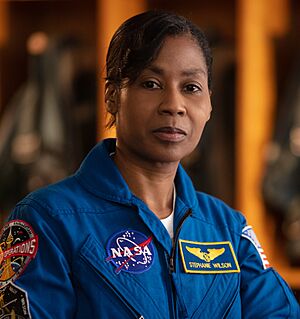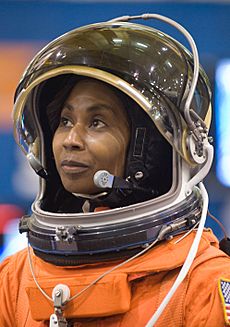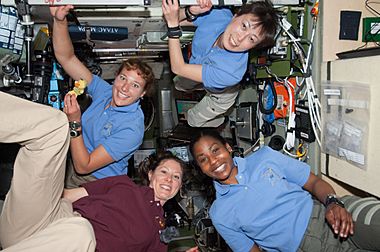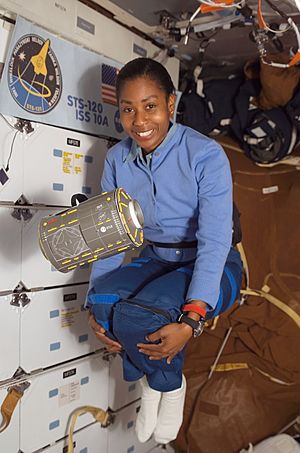Stephanie Wilson facts for kids
Quick facts for kids
Stephanie Wilson
|
|
|---|---|

Wilson in 2019
|
|
| Born |
Stephanie Diana Wilson
September 27, 1966 Boston, Massachusetts, U.S.
|
| Space career | |
| NASA astronaut | |
|
Time in space
|
42d 23h 46m |
| Selection | NASA Group 16 (1996) |
| Missions | STS-121 STS-120 STS-131 |
|
Mission insignia
|
|
Stephanie Diana Wilson (born September 27, 1966) is an American engineer and a NASA astronaut. She has flown to space on three Space Shuttle missions. She is also the second African American woman to go into space, after Mae Jemison. By 2025, she had spent 43 days in space. This was the second-longest time for any African American female astronaut, until Jessica Watkins spent more time in space in 2022.
Contents
Early Life and Education
Stephanie Wilson was born in Boston, Massachusetts, on September 27, 1966. About a year later, her parents, Eugene and Barbara Wilson, moved to Pittsfield, Massachusetts. Her father, Eugene, used his electronics training from the Navy to become an electrical engineer. He worked for companies like Raytheon and Lockheed Martin. Her mother, Barbara, worked as a production assistant for Lockheed Martin.
Stephanie went to Stearns Elementary School and Crosby Junior High School. In middle school, she had a class about different careers. She chose to interview an astronomer from Williams College, Jay Pasachoff, because she loved looking at the sky. This helped her think about a career in space. In high school, her father encouraged her to study engineering. She decided to become an aerospace engineer.
Wilson graduated from Taconic High School in Pittsfield, Massachusetts, in 1984. She then went to Harvard University and earned a Bachelor of Science degree in engineering science in 1988. In 1992, she received a Master of Science degree in aerospace engineering from the University of Texas. Later, Wilson returned to Harvard as a member of the Harvard Board of Overseers. She was also the Chief Marshal for Harvard's 362nd Commencement ceremony in 2013.
Engineering Career
Before joining NASA, Stephanie Wilson worked for the Martin Marietta Astronautics Group in Denver, Colorado, for two years. There, she was a Loads and Dynamics engineer for the Titan IV rocket. Her job was to analyze how the rocket and its cargo would handle forces during launch.
In 1990, Wilson left Martin Marietta to go to graduate school. Her research focused on how to control and model large, flexible structures in space.
After finishing her graduate studies, Wilson started working at the Jet Propulsion Laboratory (JPL) in Pasadena, California, in 1992. She was part of the team that controlled the Galileo spacecraft. She made sure the spacecraft's parts, like its antennas, pointed correctly. She also helped develop and test the spacecraft's instructions. While at JPL, Wilson also worked on a program that used special tools to measure tiny distances in space.
Becoming a NASA Astronaut

NASA chose Stephanie Wilson as an astronaut candidate in April 1996. She began her training at the Johnson Space Center in August 1996. After two years of training, she became a qualified mission specialist.
Her first duties were in the Astronaut Office Space Station Operations Branch. She worked on displays and procedures for the International Space Station. Then, she worked in Mission Control as a CAPCOM. This meant she was the main person who talked to astronauts in space from Earth. After that, Wilson worked on the Space Shuttle Main Engines, External Tank, and Solid Rocket Boosters.
Wilson has flown on three Space Shuttle missions. She was a mission specialist on STS-121. She also flew on the STS-120 mission, which delivered the Harmony connecting module to the International Space Station. In April 2010, Wilson flew as a mission specialist on STS-131.
On October 18, 2019, Wilson was a ground controller in Houston. She helped guide the first spacewalk ever done by only women, Christina Koch and Jessica Meir.
In December 2020, NASA announced that Stephanie Wilson was one of the astronauts chosen for the Artemis program. This program aims to return humans to the Moon. If selected for a Moon mission, she could be the first woman and the first African American on the Moon.
On January 31, 2024, NASA announced that Wilson would be a mission specialist on the SpaceX Crew-9 mission to the International Space Station. However, NASA later changed plans for the Boeing Starliner capsule. Because of this, Wilson was removed from the Crew-9 mission. She made a brief appearance during NASA's broadcast of the Crew-9 launch on September 28, 2024.
Spaceflight Missions
STS-121 Mission
STS-121 was a test and assembly mission to the International Space Station. It took place from July 4 to July 17, 2006. During this 13-day flight, the Space Shuttle Discovery crew tested new equipment and safety procedures. They also repaired a rail car on the Space Station. Wilson helped with the robotic arm operations. She helped inspect the shuttle, install a module, and support spacewalks. She also moved over 28,000 pounds of supplies to the ISS. The crew also did maintenance on the station and delivered a new crew member. The mission lasted 306 hours, 37 minutes, and 54 seconds.
STS-120 Mission
STS-120 was a Space Shuttle mission to the International Space Station. It flew from October 23 to November 7, 2007. The shuttle traveled 6.25 million miles. This mission delivered the Harmony module to the station. It also rearranged a part of the station's structure for future assembly. STS-120 brought a new crew member, Daniel Tani, to the station. It also brought back Clayton Anderson. The crew performed four spacewalks. They also fixed a solar array on the station using a new method. The mission lasted 15 days, 2 hours, and 23 minutes, completing 238 orbits.
STS-131 Mission

STS-131 was a mission to resupply the International Space Station. It launched before dawn on April 5, 2010, and returned on April 20, 2010. Once docked, the crew delivered over 27,000 pounds of equipment and supplies. This included a tank of ammonia coolant, which needed three spacewalks and robotics to install. They also delivered new sleeping quarters and a freezer for experiments.
During this mission, Wilson was in charge of robotics. She used the space station's robotic arm to help with spacewalks. She also used the arm to remove the "Leonardo" Multi-Purpose Logistics Module from Discovery's cargo bay. For the trip back to Earth, Wilson robotically put Leonardo back into Discovery's cargo bay. It was packed with over 6,000 pounds of hardware and science results. The STS-131 mission lasted 15 days, 2 hours, 47 minutes, and 10 seconds. It traveled 6,232,235 miles in 238 orbits.
Artemis Program
The Artemis program (which started in 2017) is NASA's plan to return humans to the Moon. In 2020, Wilson was chosen as one of eighteen astronauts for the Artemis team.
Personal Life
Stephanie Wilson is a Christian. She is also a member of the Alpha Kappa Alpha sorority. Her hobbies include skiing and stamp collecting. She married Julius "BJ" McCurdy in June 1999, but they divorced in 2003.
Awards and Honors
- NASA Distinguished Service Medal (2009, 2011)
- NASA Space Flight Medal (2006, 2007, 2010)
- Honorary Doctorate of Science from Williams College (2011)
- Harvard College Women's Professional Achievement Award (2008)
- Harvard Foundation Scientist of the Year Award (2008)
- Young Outstanding Texas Exes Award (2005)
- Johnson Space Center Innovation Group Achievement Award (2013)
- Johnson Space Center Director Commendation Award (2013)
- Salem Trailblazer Award (2019)
Images for kids
-
Wilson in the US lab during STS-121
-
Stephanie Wilson in the Cupola during STS-131, with JAXA astronaut Naoko Yamazaki
-
Observing the condition of the protective shutters in the Cupola during STS-131
-
Group photo with Naoko Yamazaki and Dorothy Metcalf-Lindenburger
-
STS-131 crew playing around during their time work
See also
 In Spanish: Stephanie Wilson para niños
In Spanish: Stephanie Wilson para niños












